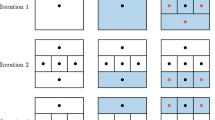Abstract
Any real-valued nonlinear function in 0–1 variables can be rewritten as a multilinear function. We discuss classes of lower and upper bounding linear expressions for multilinear functions in 0–1 variables. For any multilinear inequality in 0–1 variables, we define an equivalent family of linear inequalities. This family contains the well-known system of generalized covering inequalities, as well as other linear equivalents of the multilinear inequality that are more compact, i.e., of smaller cardinality. In a companion paper [7]. we discuss dominance relations between various linear equivalents of a multilinear inequality, and describe a class of algorithms for multilinear 0–1 programming based on these results.
Similar content being viewed by others
References
E. Balas, “Duality in discrete programming: The quadratic case”,Management Science (Theory) 16 (1969) 14–32.
E. Balas, “Minimax and duality for linear and nonlinear mixed-integer programming”, in: J. Abadie, ed.,Integer and nonlinear programming (North-Holland, Amsterdam, 1970) pp. 385–418.
E. Balas, “A duality theorem and an algorithm for (mixed)-integer nonlinear programming”,Linear algebra and Its Applications 4 (1971) 1–15.
E. Balas, “Facets of the knapsack polytope”,Mathematical Programming 8 (1975) 146–164.
E. Balas and J.B. Mazzola, “Linearizing nonlinear 0–1 programs: Some new techniques”, Paper presented at the ORSA/TIMS Meeting in Milwaukee, October 15–17, 1979.
E. Balas and J.B. Mazzola, “Linearizing nonlinear 0–1 programs”, MSRR No. 467, Carnegie-Mellon University, Pittsburgh, PA October, 1980.
E. Balas and J.B. Mazzola, “Nonlinear 0–1 programming: II. Dominance relations and algorithms”, Mathematical Programming 30 (1984) 22–45 (this issue).
R. Fortet, “L'algèbre de Boole et ses applications en recherche opérationnelle”,Cahiers du Centre d'Etudes de Recherche Opérationnelle 1 (1959) 5–36.
R. Fortet, “Applications de l'algèbre de Boole en recherche opérationnelle”,Revue Francaise de Recherche Opérationnelle 4 (1960) 17–26.
F. Glover and E. Woolsey, “Further reduction of zero-one polynomial programming to zero-one linear programming problems”,Operations Research 21 (1973) 141–161.
F. Glover and E. Woolsey, “Converting the 0–1 polynomial programming problem to a linear 0–1 program”,Operations Research 22 (1974) 180–182.
D. Granot and F. Granot, “Generalized covering relaxation for 0–1 programs”,Operations Research 28 (1980) 1442–1449.
D. Granot, F. Granot and J. Kallberg, “Covering relaxation for positive 0–1 polynomial programs”,Management Science 25 (1979) 264–273.
F. Granot and P. L. Hammer, “On the use of Boolean functions in 0–1 programming”,Methods for Operations Research 12 (1971) 154–184.
P. L. Hammer and S. Rudeanu,Boolean methods in operations research and related areas (Springer, Berlin, New York, 1968).
P.L. Hammer, P. Hansen and B. Simeone, “Best linear relaxations for quadratic 0–1 optimization”, Research Report 79-37, Department of Combinatorics and Optimization, University of Waterloo, 1979.
P. Hansen, “Un algorithme pour les programmes non linéaires en variables 0–1”,Comptes Rendus de l'Académie des Sciences (Paris) 270 (1970) 1700–1702.
P. Hansen, “Methods of nonlinear 0–1 programming”,Annals of Discrete Mathematics 5 (1979) 53–71.
H. Taha, “A Balasian-based algorithm for zero-one polynomial programming,”Management Science 18B (1972) 328–343.
L. J. Watters, “Reduction of integer polynomial programming to zero-one linear programming problems”,Operations Research 15 (1967) 1171–1174.
Author information
Authors and Affiliations
Additional information
Research supported by the National Science Foundation under grant ECS7902506 and by the Office of Naval Research under contract N00014-75-C-0621 NR 047-048.
Rights and permissions
About this article
Cite this article
Balas, E., Mazzola, J.B. Nonlinear 0–1 programming: I. Linearization techniques. Mathematical Programming 30, 1–21 (1984). https://doi.org/10.1007/BF02591796
Received:
Revised:
Issue Date:
DOI: https://doi.org/10.1007/BF02591796




